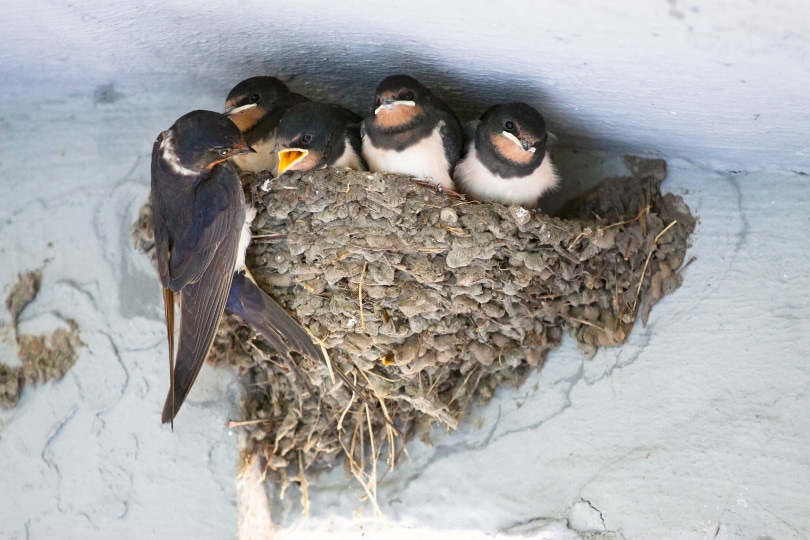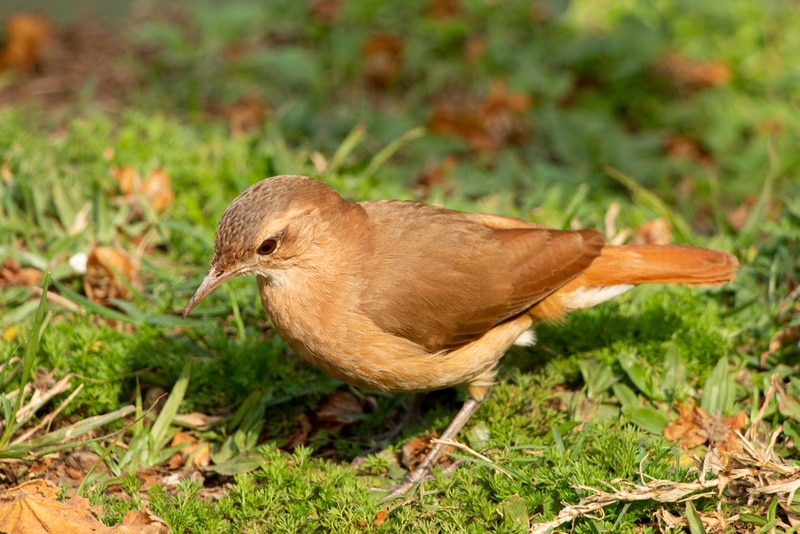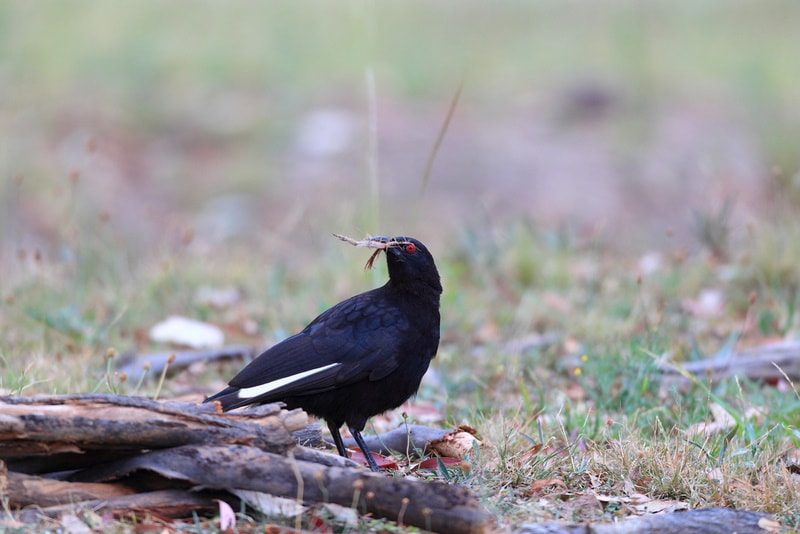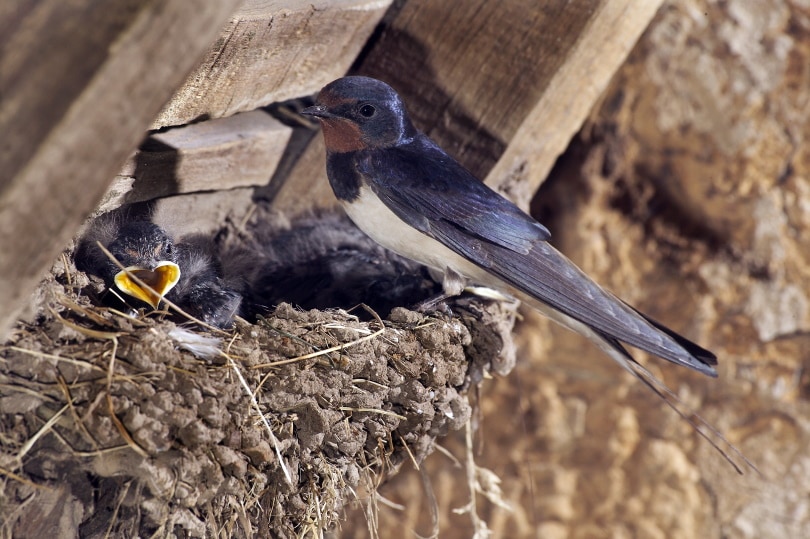12 Birds That Make Mud Nests (With Pictures)
Last Updated on

Birds are wonderful and majestic creatures that construct their homes in the most creative ways. Just like humans have a desire to decorate and take care of their homes, so do birds. They are intelligent beings who constantly search for ways to upgrade their nest to keep their young safe.
With their primary goal set in their minds, birds search for the ideal material to help them craft a perfect shelter. That means looking out for all the dried twigs, leaves, moss, or even grass. A few birds have especially interesting and innovative solutions for their nests.
You’ve heard of nests made out of twigs, but have you heard of mud nests? In this article, we will dive into the birds’ perspective and explore their nest-making skills. We will find which birds own this unique crafting ability since there are only a few with this particular skill.

The 12 Birds That Make Mud Nests
1. Black-billed Magpie

| Species | Pica Hudsonia |
| Size | 18–24” |
| Habitat | Streamside groves, farm country, suburban areas, forest edges |
| Distribution | Southern Alaska, western Canada, and the northwest United States |
These magnificent birds attract the attention of many with their rich black and white plumage that frequently appears with a hint of blue. Another unique fact about these birds is that they mate for life.
Together with their partner, they collect twigs and other collectibles they find on the ground and construct the top half of the nest. The bottom half is built out of mud and is shaped like a dome lined with grass. These nests can be found usually on top of trees in forests or grasslands, but sometimes you may even see them in urban areas. It takes them up to 50 days to make a nest that is usually 20 inches wide and 30 inches long.
2. Black Phoebe
https://www.instagram.com/p/CrbU6DnxZc7/
| Species | Sayornis nigricans |
| Size | 6” |
| Habitat | Around still or running water (streams, rivers, lakes, Pacific Ocean) |
| Distribution | Western and central North America, far west of South America |
These small and plump flycatchers can be found anywhere near water. They have a dark upper body and clear white belly, with their black wings turning light gray toward the ends. You can easily recognize them by their distinctive tail-pumping. If you are searching for these interesting birds, look out for their sharp, scratchy chip.
These wonderful songbirds make mud nests, cup-shaped, usually anchored in nooked spaces near water, bridges, or even eaves of buildings. These nests, which only the females build, are lined with grass, other plants, or sometimes even hair.
3. Eastern Phoebe
https://www.instagram.com/p/CbulgrsuTFP/
| Species | Sayornis phoebe |
| Size | 5–7” |
| Habitat | Yards, parks, woodlands |
| Distribution | During spring, for breeding in Central America, in winter migrating south |
The Easter Pheobe is an elegant-looking bird with a white base around the belly, and a smoky brownish color pallet on her wings, head being the darkest body part. You can recognize these birds as they are one of the first to announce spring with their eponymous songs.
These plump songbirds usually place their nests crafted from mud and grass in protected nooks. They can make these nooks on bridges or even barns and houses, which makes them distinctive to people. What is unique for these birds is that they have a habit of reusing and even renovating old nests of Barn Swallows and American Robins.
4. American Flamingo
https://www.instagram.com/p/Cq-4H1CqDvR/
| Species | Phoenicopterus ruber |
| Size | 60” |
| Habitat | Shallows of salt or brackish water, around alkaline lakes |
| Distribution | The northern coast of South America and Caribbean Islands |
The American Flamingo is one of the largest flamingo species. Their name comes from Spanish and translates to ‘’flame hot’’, referring to their distinctive hot pink colored feathers, with black on the edges of the wings. They are very social creatures that live in flocks, sometimes as big as thousands of flamingos.
When building their nests, both male and female flamingos work together to create a perfect home and shelter their young. They build their muddy structures on top of mudflats and shape them into mounds. They tend to get quite aggressive when it comes to defending their nests.
5. Apostlebird

| Species | Struthidea cinerea |
| Size | 13” |
| Habitat | Woodlands near water and open dry forests |
| Distribution | Eastern Australia and east of South Australia |
This beautiful bird’s head, neck, and breasts are coated with a lighter gray shade, while the wings are brown. The Apostlebird, also known as the Gray Jumper, is a very social creature. They usually travel in a flock of 12 but sometimes live in a flock of 30 birds.
They make their nests into large muddy bowls and place them ideally on horizontal branches as high as 65 feet above the ground. The muddy nests are lined with grass which gives them additional reinforcement.
6. Barn Swallow
https://www.instagram.com/p/CjKlH8eqFKn/
| Species | Hirundo rustica |
| Size | 6–8” |
| Habitat | Meadows, ponds, fields, coastal waters, sheds, barns, bridges, etc. |
| Distribution | Most of North America, during winter, migrating to south |
You can recognize this graceful and elegant-shaped bird flying gracefully over fields, cruising above open waters, searching for prey. Their long and forked tail is the most distinctive part of this species. Their colors can differ from steel-blue to cinnamon reds, creating beautiful, bold contrasts in their feathers.
The Barn Swallow earns its name by its clear preference of making mud nests in already human-made structures; these nests are usually nooked to vertical walls of barns or sheds. They are lined with grass, twigs, leaves, or even plastic parts. Both male and female birds participate in making these charming muddy homes.
7. Cliff Swallow
https://www.instagram.com/p/CqWWoVfsK8y/
| Species | Petrochelidon pyrrhonota |
| Size | 5” |
| Habitat | Vertical cliff faces, or even bridges and overpasses |
| Distribution | Mexico, Central America, eastern South America |
These rich-colored birds look majestic under the proper lighting. Their feathers have a wide range of colors varying from deep blue and black to brick and cinnamon red shades with white undertones.
This bird species nest in larger groups, stacking their nests closer together. Since they build their nests around the edges of cliffs or bridges, they use mud to craft these igloo-like structures, lining them with grass, leaves, or sometimes even horsehair to provide additional support.
8. Cave Swallow
https://www.instagram.com/p/CqirgIXOAdY/
| Species | Petrochelidon fulva |
| Size | 5–6” |
| Habitat | Caves, sinkholes, buildings, bridges, or culverts |
| Distribution | Mexico and the Caribbean Islands |
The shades of color on these charming creatures differ from dark on top of their bodies to dark underneath. True to their name, the Cave Swallows prefer to nest around entrances of caves, sharing their shelter with bats. Recently this species of Swallow has been searching for places to nest under bridges and expanding more to the north. They build these crafted nests from mostly mud and accumulated waste from bats and then cement them onto walls of caves and ledges.
9. Purple Martin

| Species | Progne subis |
| Size | 7–8” |
| Habitat | Near waters in natural cavities, and in martin houses |
| Distribution | North America and Mexico |
The Purple Martin bird has a beautiful specter of deep dark colors, from purple and blue to black-brown. During summer, you can find these birds mostly cooped up in the martin houses that more people choose to keep in their backyards. This type of nesting is incredibly interesting since it seems like having a tiny bird neighborhood in your garden. Other Purple Martins still choose the old-fashioned ways of nesting. They search for twigs, leaves, and straw to make the structure and then gather mud to add support for holding everything in its place.
10. Rufous Hornero

| Species | Furnarius rufus |
| Size | 6–9” |
| Habitat | Cultivated areas, open habitats with bare soil, parks, and gardens, sometimes near water |
| Distribution | Eastern South America |
These gorgeous birds have reddish-brown, or copper feathers, with more pale coloring on the edges of the back and rump. Their tails are a bit darker than the rest of the body. You can mostly see this species flying in lowlands or dry valleys.
These birds are specific for their lovely spherical nests. They make these dome-shaped nests primarily out of mud, clay, and straw, and they can be as big as 12 inches long and high. Because the wall of these structures is so thick, they can sometimes weigh about 11 pounds.
Even though making one of these nests takes such a long process, the Rufous Hornero never reuses the same nest twice. They will often rebuild the same structure on top of the old one but never return to the former. Those old nests that are left abandoned serve as a home for other species since they provide an amazing shelter against predators.
11. White-Winged Chough

| Species | Corcorax melanorhamphos |
| Size | 18” |
| Habitat | Open forests and woodlands |
| Distribution | Eastern Australia |
The White-winged Chough is a highly social creature; they live in groups of up to 20 birds. They are birds with pompous, completely black feathers, and when in flight, you can spot the bird’s white-patterned wings.
They search for an appropriate area to nest, and that is usually a wet area, with lots of leaf litter and accessibility to mud for making nests. They build their nests on horizontal branches, often as high as 50 feet. If there are not many rainy days to help add moisture to the mud, it may take these birds several months to craft their nests. If they don’t manage to find enough mud, they may even use cattle manure.
12. Hamerkop
https://www.instagram.com/p/B5UvR8Vq2IQ/
| Species | Scopus umbretta |
| Size | 22” |
| Habitat | Anywhere close to water, lakes, rivers, ponds, dams, and irrigation channels |
| Distribution | Sub-Saharan Africa. |
The feathers of a Hamerkop are a unique brownish color, with purple hints on the back. These birds usually spend most of their time in pairs but can be seen in larger groups of 10.
This bird is a real artist when it comes to crafting a nest. They make an astonishing mud structure that tends to get as big as 6 feet high and 6 feet wide, with up to 100 times the bird’s weight. These nests are an impressive project that takes 3-6 weeks to build, and it may contain 8,000 pieces collected patiently and carefully by the Hamerkop. It begins as a stick framework and ends up as a dome that is so strong it can support a grown man.

How do birds make mud nests?
The first step is to find a convenient spot to build on. These nests will be stronger than regular nests but still have to be closer to water and mud to have enough material at their disposal. The birds start by building a framework, or a basic structure out of twigs or sticks, then top that off with mud clay. The insides of the nests can be lined with straw, leaves, feathers, or any other material that is easy to find and that will provide their nest with additional support and insulation.
Can these nests break easily?
They are pretty solid and durable since they craft these structures with multiple layers of material and then stick everything up with mud. If the mud is not sticky enough to support the structure, which often happens when there isn’t a lot of rain, then birds use cattle manure to help them secure the nest.

What happens to the nests of birds that migrate?
For breeding, these mud nesting birds migrate most to the south during winter. After migration, some species, like an Eastern Phoebe, come back to reuse the old homes they left behind. With a bit of renovating, these birds can again live in a completely durable and strong nest. Other birds, like a Hamerkop, never reuse old nests, no matter how strong or grandiose they’ve crafted; they will instead make new ones on top of the old ones.

Conclusion
We gave you an insight into most bird species that craft their nests using mud. This is a fascinating topic that not many people know about. It is fun to learn about, especially since you might find some of these birds in your backyard or even find their mud nests. After reading this article, you will know how to recognize the mud nests, and you will even be familiar with the looks of these birds if you ever encounter them.
These are a work of art, and these astonishing birds are little artists. They design and craft their own homes just like people do, searching for the most practical way to make a functional and safe place for them and their young ones.
Featured Image Credit: Olexandr Panchenko, Shutterstock
About the Author Robert Sparks
Robert’s obsession with all things optical started early in life, when his optician father would bring home prototypes for Robert to play with. Nowadays, Robert is dedicated to helping others find the right optics for their needs. His hobbies include astronomy, astrophysics, and model building. Originally from Newark, NJ, he resides in Santa Fe, New Mexico, where the nighttime skies are filled with glittering stars.
Related Articles:
Monocular vs Telescope: Differences Explained (With Pictures)
10 Types of Hummingbirds in Arkansas (With Pictures)
8 Types of Hummingbirds in Nebraska (With Pictures)
5 Types of Hummingbirds in Idaho (With Pictures)
3 Types of Hummingbirds in Mississippi (With Pictures)
8 Types of Hummingbirds in Kansas (With Pictures)
5 Types of Hummingbirds in West Virginia (With Pictures)
5 Types of Hummingbirds in Ohio (With Pictures)
